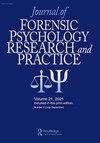重新审视心理变态量表修订(PCL-R)与性累犯与非性累犯的关系
IF 1.1
4区 心理学
Q4 CRIMINOLOGY & PENOLOGY
Journal of Forensic Psychology Research and Practice
Pub Date : 2022-03-16
DOI:10.1080/24732850.2022.2044712
引用次数: 2
摘要
精神病在亚洲样本中的作用尚未得到很好的报道。本研究比较了修订后的心理变态量表(PCL-R)对性累犯和非性累犯的预测能力。2005年,通过PCL-R对451名男性高危性犯罪者进行了评估,到2016年为止,共有445名犯罪者被再犯。在性累犯(n = 201)和非性累犯(n = 244)之间的比较中,因子1(人际情感)和因子2(情感)的效应量最高,为0.53。我们进一步测试了四个方面的不同形式的累犯使用单向多变量方差分析(MANOVA)。性惯犯在第二方面的得分明显高于轻罪(n = 59, d = 0.79)、抢劫犯(n = 31, d = 0.58)、窃贼(n = 33, d = 0.57)和杀人犯(n = 65, d = 0.54)。在区分性犯罪者和轻罪方面,因子2的效应值最高(d = 0.79),其次是因子1 (d = 0.75)和因子1 (d = 0.73),分别用于区分性犯罪者和入室行窃。最后,层次二元逻辑回归分析显示,只有面向2(27.3%)预测性再犯,表明人格特质在预测性暴力方面比行为特质更重要。本文章由计算机程序翻译,如有差异,请以英文原文为准。
Revisiting the Relationships between Psychopathy Checklist-Revised (PCL-R) Facets and Sexual Recidivists versus Nonsexual Recidivists
ABSTRACT The role of psychopathy in Asian samples has not been well reported. This study tests the ability of the Psychopathy Checklist-Revised (PCL-R) to predict sexual recidivists compared to nonsexual recidivists. A total of 451 Korean male high-risk offenders were assessed by the PCL-R in 2005, and 445 offenders recidivated by 2016. Factor 1 (interpersonal-affective) and facet 2 (affective) showed the highest effect size of 0.53 in a comparison between sexual recidivists (n = 201) and nonsexual recidivists (n = 244). We further tested four facets for different forms of recidivism using one-way multivariate analysis of variance (MANOVA). Sexual recidivists scored significantly higher in facet 2 than misdemeanors (n = 59, d = 0.79), robbers (n = 31, d = 0.58), burglars (n = 33, d = 0.57), and murderers (n = 65, d = 0.54). The highest effect sizes were found in facet 2 (d = 0.79) to separate sex offenders from misdemeanors, followed by Factor 1 (d = 0.75) and facet 1 (d = 0.73) to separate sex offenders from burglars. Finally, hierarchical binary logistic regression revealed that only facet 2 (27.3%) predicted sexual recidivism, indicating the importance of personality traits over behavioral traits in predicting sexual violence.
求助全文
通过发布文献求助,成功后即可免费获取论文全文。
去求助
来源期刊
CiteScore
1.80
自引率
12.50%
发文量
53

 求助内容:
求助内容: 应助结果提醒方式:
应助结果提醒方式:


